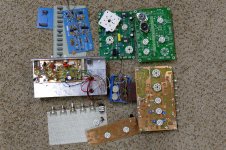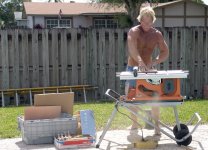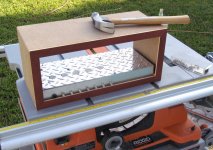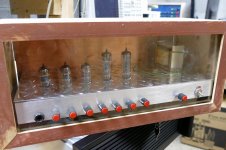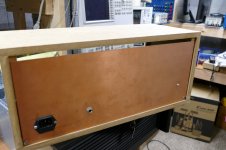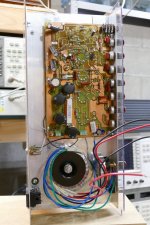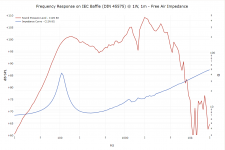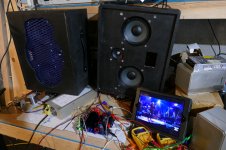Looking forward to hearing about your projects!I have a few of the HV modules and want to build something this winter.
That's a nice solution if using 12A*7 preamp stages and 12V6s in the output.12V is much easier to deal with and 12V6's work just as good and are still reasonable in price.
Unfortunately for me, I have lots of oddball 6V power valves (like 6BK5s), and no 12V ones. But in principle, since I'm powering the heaters with DC and don't have to worry about ground-referencing the centre of the heater wire, I could simply string two 6BK5s in series, and power the pair from 12V. Same thing with any two identical 6V heater preamp valves.
The only catch is that this only works for amp designs that use even numbers of identical tubes, throughout the whole circuit. Not a huge catch, really, with a push-pull design, and some thought put into the preamp design.
Going out a little further along that limb, the sweet spot for low-cost, high-current, cheap, switching power supplies is now thrift-store laptop chargers. All the ones I've seen are rated at either 18.5V or 19V. Small ones usually start at about 3.5 amps capacity, and many go considerably higher.
19 volts is temptingly close to three 6.3 volt heaters in series. The catch is coming up with an amp design that uses three of each type of valve!
How about an amp with one push-pull output for the "drive" channel, and a separate single-ended output, driving a second speaker, for the "clean" channel? That could use three identical power valves.
-Gnobuddy
I have 30 12BK5's. One of the projects is using three of these tubes in parallel to drive a old C12R using a 1100:8 ohm transformer that I got out of a console stereo. The original tube was a 7695 which put out 4.5W at 140V. The three 12BK5's will add up to the current originally used through the transformer. And it is fairly hefty for a 5W trany, but then again it was for hifi and had an extended bass response compared to guitar work. I figure the three tubes and the 3.5W they are rated for might get me around the 10W level. The C12R should be able to handle that.
I have a few 12V laptop type supplies with different current ratings. The BK5's heaters are power hungry, I originally was going to use 12W6's but three of them might be too much current through the trany. Same current for the two, the BK is a smaller tube and might run a little hot. With having 30 of them I have a few tube changes to keep the amp running.
I was thinking of having a simple amp like a Champ. The thing is, which one the Blackface with the treble and bass controls or the Tweed with just tone? I decided to go with both using a four pole switch with separate knobs for the tone and the treble and bass. Just point the switch at the tone control(s) you want.
Then I had another thought. I could put another channel in there and have one channel use the Tweed tone control while the other uses the treble and bass tone stack. Flipping the switch flips the tone controls to the other channel. So rather than two you have four flavours. And then you can also blend both channels. Or at least that is the theory. Got to see if it will work.
I have a few 12V laptop type supplies with different current ratings. The BK5's heaters are power hungry, I originally was going to use 12W6's but three of them might be too much current through the trany. Same current for the two, the BK is a smaller tube and might run a little hot. With having 30 of them I have a few tube changes to keep the amp running.
I was thinking of having a simple amp like a Champ. The thing is, which one the Blackface with the treble and bass controls or the Tweed with just tone? I decided to go with both using a four pole switch with separate knobs for the tone and the treble and bass. Just point the switch at the tone control(s) you want.
Then I had another thought. I could put another channel in there and have one channel use the Tweed tone control while the other uses the treble and bass tone stack. Flipping the switch flips the tone controls to the other channel. So rather than two you have four flavours. And then you can also blend both channels. Or at least that is the theory. Got to see if it will work.
Got anything to share that might bring the thread back to life? ......I believe to renew the interests, some new criteria have to be given, e.g., even lower cost, battery-powered, etc.
I lost my job of 41 years as the challenge that spawned this thread was winding down. I had 3 weeks to vacate the house that I had lived in for 37 years, so lots of stuff was sold, given away, or just tossed in the trash. What was to be a slow orderly planned move turned into a hasty exit, with stuff thrown into random boxes sometimes by friends who had no idea what some of it was.
The little amp that was my ultimate cheapskate design got tossed in a box, and was found about 2 years ago. It has been rebuilt into something that I actually use and documented in previous posts. The "furball" prototype that was used to test out that "final" design has been found and will be used for yet another version if the idea pans out.
In a quest to find parts to fix a customer's dead HiFi amp, I opened a box......surprise! There were a few un finished, and some barely started breadboards, a PC board for a guitar preamp where only the tube sockets and input jack had been installed, a germanium Fuzz Face clone I made back in about 1970, some PAIA synthesizer experimenters boards, and a couple of my HiFi PC boards hacked to fit bigger tubes. So, there will be some new material.
During the original challenge, I had designed another higher powered amp, expressly for the purpose of seeing how much amp can be made for $99.99 USD. There were two version. The one that saw the most testing and guitar playing used all 9 pin tubes, made about 20 watts and could go from clean to full metal racket. It still has not been found. The other version used the same 9 pin preamp / tone / PI as the all 9 pin version, is just used octal output tubes. It is the board seen in the lower right of the picture. There will be some serious hacking on this board in the near future to see what can be made from it.
One shortcoming of the previous contest appears to be the lack of a judging panel - who’s to say if a design is good or not when nobody seems to agree on what sounds the best or the most versatile, etc. IMO, the judges should be professional musicians not amp designers/builders.
I doubt that too many serious professional musicians are reading this forum, but many of the readers here do play the guitar, and know what type of tone they are looking for. Let the perspective builder judge for himself whether he wants to build one of these designs, steal an idea or two from one of them, or just learn the "how and why" of the design. As with cars, clothing, food, or most everything else what works for one person won't for everybody else.
The rules set forth for the original challenge imposed some limitations on the amp designs. After the challenge was over and the thread had gone cold I found my original $40 amp design, and revised it into something that I enjoyed playing. That effort generated a new amp (Amp 1.5) that I use. I have some ideas for a revision that will be looked into. Some more new material may come from the stuff I found in the box, but I really need to find the missing 9 pin amp. It rocked, and was nearly ready for prime time.
It would help to have some sound samples or videos of the amp in action, but we all have different playing styles and skill levels on the guitar. It is also hard to judge the tone of an amp if the video was made with a cell phone or pocket camera like my synth video, so no judging can be accurate unless all of the perspective amps are played in the same venue by the same player, and recorded on the same equipment. So, within these constraints, we will just do what we can.
I for one have lost most of my playing ability to nerve damage (numb fingers). There was an ugly period a year or so back when I couldn't drive a car, and couldn't hold a fork to eat. That's mostly over, but my hands will never be what they were. I can solder now but SMD stuff is still out, and guitar playing is challenging. Even so, I will try to do some kind of demo with Amp 1.5.
Attachments
It is amazing how something like posting about an amp I made about 6 years ago can spark up an old memory.
I looked through my pictures from the original thread and realized why I couldn't find the remains of Amp 2.0. I had been looking in smallish boxes for a PC board. I should be looking for a complete amp! I found pictures from 2011 of me building a cabinet for this sucker in Florida. In the first picture you can see the chassis with 5 tube sockets standing vertically on it's side, and the 4 tube amp board (now Amp 1.5) in a box. In the second picture the chassis in in the box sitting on top of the table saw. These are the last known pictures of amp 2.0.........
Until today. The old pictures lead me to believe that there might just be a complete amp somewhere, but I honestly don't remember building one. If it existed, there can't be to many places for it to hide. There is an abandoned mobile home on the property that I use for storage. It is rather run down, and can't be locked up, so I don't keep valuable things there, but it was sitting in a box on the floor in a closet along with a big 48 volt 15 amp power supply that I have been looking for.
I brought it back here and took a few pictures. It is nearly finished.....well maybe. I need to wire up the transformers, and plug it in! The Antek toroid under the deck is the OPT. This amp made over 20 watts at full crank, so there is an "L" pad "power brake" to turn it down.
I will be plugging this baby in as soon as I finish a few commitments and clear off my bench.
I looked through my pictures from the original thread and realized why I couldn't find the remains of Amp 2.0. I had been looking in smallish boxes for a PC board. I should be looking for a complete amp! I found pictures from 2011 of me building a cabinet for this sucker in Florida. In the first picture you can see the chassis with 5 tube sockets standing vertically on it's side, and the 4 tube amp board (now Amp 1.5) in a box. In the second picture the chassis in in the box sitting on top of the table saw. These are the last known pictures of amp 2.0.........
Until today. The old pictures lead me to believe that there might just be a complete amp somewhere, but I honestly don't remember building one. If it existed, there can't be to many places for it to hide. There is an abandoned mobile home on the property that I use for storage. It is rather run down, and can't be locked up, so I don't keep valuable things there, but it was sitting in a box on the floor in a closet along with a big 48 volt 15 amp power supply that I have been looking for.
I brought it back here and took a few pictures. It is nearly finished.....well maybe. I need to wire up the transformers, and plug it in! The Antek toroid under the deck is the OPT. This amp made over 20 watts at full crank, so there is an "L" pad "power brake" to turn it down.
I will be plugging this baby in as soon as I finish a few commitments and clear off my bench.
Attachments
There are two. Both have the famous "dollar menu," a list of tubes for a dollar or less. Most of the types useful for audio have been sold out.
ESRC in Orlando:
Vacuum Tubes - Audio Tubes - ESRC Vacuum Tubes - Electron Tubes
Radio Electric Supply near Ocala:
www.vacuumtubes.net
ESRC in Orlando:
Vacuum Tubes - Audio Tubes - ESRC Vacuum Tubes - Electron Tubes
Radio Electric Supply near Ocala:
www.vacuumtubes.net
And there's the end of an era, slipping by as we watch. A rather short-lived second life for NOS tubes/valves, made possible by the Internet, decades after their heyday.Most of the types useful for audio have been sold out.
I still see some oddball types that could be used for audio, based on a quick look at the datasheets, but nothing mainstream.
-Gnobuddy
Let us know if you find out!Wonder if a 6AU6 would sound ok somewhere between triode and pentode operation with maybe 30-60 gain. No shortage of them.
The little beam-tetrode in a 6JW6 sounds good (to me) in mild overdrive, but gets blubbery and then harsh if pushed too hard. I've wondered about trying it in triode mode, or, as you say, somewhere in between triode and pentode.
-Gnobuddy
I think a lot of the sound we like out of guitar amps has to do with high frequency roll-offs. You don't want to hear high frequencies from a guitar amp. They're just nasty.
I think that the reason we like those Jensen speakers from the 1960s is that they rolled off steeply above 5kHz. Likewise, those 12AX7 triodes (with their high output impedance over 50k ohms) driving Fender tone stacks or Ampeg-style James tone controls are loaded down like crazy, again rolling off highs.
Then we jack up the highs with the Treble control or the Presence (NFB loop) control and make a peak in the presence frequency range that's still rolled off above 5kHz by the speaker.
And then there's the cheap, nasty OPTs used, which in my experience sound better for guitar than better quality OPTs. Why? I think... because of worse leakage inductance and winding capacitance, and therefore yet another high frequency roll-off (and spurious resonances).
If you start replacing those loaded down 12AX7s with lower rp, higher gm 6DJ8 or whatever, and put a good quality OPT in there, you start getting that more 'hi-fi' sound, and we miss the 'warmth' we had before. So...
The classic circuits really do what we want them to do. They screw up the signal real good. No highs. Rolled off lows (below 80Hz is not really useful in a guitar amp). High levels of 2nd harmonic distortion, or maybe 3rd harmonic for a brassier sound.
So, what do you think? Am I totally off base?
--
I think that the reason we like those Jensen speakers from the 1960s is that they rolled off steeply above 5kHz. Likewise, those 12AX7 triodes (with their high output impedance over 50k ohms) driving Fender tone stacks or Ampeg-style James tone controls are loaded down like crazy, again rolling off highs.
Then we jack up the highs with the Treble control or the Presence (NFB loop) control and make a peak in the presence frequency range that's still rolled off above 5kHz by the speaker.
And then there's the cheap, nasty OPTs used, which in my experience sound better for guitar than better quality OPTs. Why? I think... because of worse leakage inductance and winding capacitance, and therefore yet another high frequency roll-off (and spurious resonances).
If you start replacing those loaded down 12AX7s with lower rp, higher gm 6DJ8 or whatever, and put a good quality OPT in there, you start getting that more 'hi-fi' sound, and we miss the 'warmth' we had before. So...
The classic circuits really do what we want them to do. They screw up the signal real good. No highs. Rolled off lows (below 80Hz is not really useful in a guitar amp). High levels of 2nd harmonic distortion, or maybe 3rd harmonic for a brassier sound.
So, what do you think? Am I totally off base?
--
This guy seems to like them for all sorts of emotional reasons, and maybe a few technical ones too: VinylSavor: Tube of the Month : The 6SF5Any opinions on the 6SF5 that is a single, octal, hi-mu triode similar 1/2 of a 12AX7?
Me, I just go off the curves, and, as you say, they look a lot like one of the triodes in a 12AX7. Roughly 200V on the anode and -1.5 V on the grid gets you about 1 mA anode current. Yup, definitely a lot like half a 12AX7!
So, if you like 12AX7s, and would like to try an octal version, why not? It looks like the perfect candidate.
I grew up with transistors, so to me, noval valves look big, and octals are enormous. So I tend to prefer novals, and the cute little seven-pin valves too. 6AV6 also looks like half a 12AX7, with a useless pair of diodes thrown in. Useless from our guitar-centric viewpoint, that is.
-Gnobuddy
I have a couple of guitar pedals that are supposed to have speaker emulation built-in. Before I try to build my own, maybe I should try one of those pedals between a guitar and my nasty-sounding DIY amp to see if they improve things.
That sounds like a worthy experiment. It would be interesting to know what those speaker emulators are actually doing. Just EQ?
I once put a line level out from the OPT secondary of my old Fender amp (Deluxe Reverb I've had since I was in my 20s). I tried it first as a simple two-resistor voltage divider and found the highs were utterly nasty. I looked at the freq resp curves of a bunch of Jensen and Celestion guitar speakers and decided to put in a single-cap LPF with -3dB at about 5kHz. (That's what I remember, but perhaps it was lower, more like 3kHz.) That sounded pretty good to me. I played a gig where the sound guy took that line out, fed it into a transformer (to balance it), and fed that to an input strip on the mixing board. It worked! It actually sounded pretty good. He said he didn't have to EQ it much at all, but I never knew exactly what he did. That led me to the conclusion that a lot of the guitar amp's sound had to do with frequency response.
I've attached the frequency response graph of my own favorite guitar speaker, the Jensen C12N. It's very similar to the Eminence speaker you posted earlier.
Another epiphany about guitar amps came when I was playing with 'tone stacks.' Have you ever put an Ampeg-version James tone control in a Fender amp? Want to know what it sounds like? It transforms the amp into a sonic Ampeg doppelganger, at least as far as the clean sound goes.
So, I took away that if you take a so-so amp, put a nice speaker on it (with a sound you like), and make sure the 'tone stack' you use has the kind of EQ/phase bumps and valleys you prefer, you can get that amp to sound pretty OK, at least as far as its clean sound is concerned. Overdrive sound is a different matter.
Attachments
Last edited:
Re: guitar speaker FR --
In the rock guitar world, players apply a lot of low treble boost. Also, the audience doesn't get the sound pointed at their knees, they get it right in the face.
Did you ever see the Duncan Amps Tone Stack Simulator app?
TSC
It's pretty cool. It lets you see the FR curves of a few classic guitar amp tone control circuits. It's interesting to see that with the blackface Fender circuit, the flattest response is with the Bass and Treble controls set to almost 0. In other words, the controls offer all boost and just a tiny bit of cut. Since everybody thinks a kind of 'flat' response is reached with the Bass and Treble controls at 5, combined with the frequency response of the speakers used, you can see that the resulting response is pretty complex (or messed up, depending on your point of view).
I have a lot of respect for those amp model programmers at Line 6, et al.
--
In the rock guitar world, players apply a lot of low treble boost. Also, the audience doesn't get the sound pointed at their knees, they get it right in the face.
Did you ever see the Duncan Amps Tone Stack Simulator app?
TSC
It's pretty cool. It lets you see the FR curves of a few classic guitar amp tone control circuits. It's interesting to see that with the blackface Fender circuit, the flattest response is with the Bass and Treble controls set to almost 0. In other words, the controls offer all boost and just a tiny bit of cut. Since everybody thinks a kind of 'flat' response is reached with the Bass and Treble controls at 5, combined with the frequency response of the speakers used, you can see that the resulting response is pretty complex (or messed up, depending on your point of view).
I have a lot of respect for those amp model programmers at Line 6, et al.
--
I really was thinking about doing a Fet into PWM amp for a light weight pocket amp. But with all the tube talk I am thinking of doing a Marshall inspired amp with 12V6's in back. The laptop brick I have says 12V out at 5A, we will see what it can do. I might go for some reverb also, might bring the weight up to 20lbs.


thinking about doing a Fet into PWM amp for a light weight pocket amp.
I must confess my sin.....wait a minute, wrong forum.. OK, I ventured into the dark side......I saw this and couldn't resist it. 600 watts for $81....
So I got the board Friday, wired it up to a big A$$ 48 volt switcher, connected my DIY "blow proof" speakers, plugged an iPAD up to the input jacks and blasted the neighbors off and on for most of yesterday.....and I'm underground in a basement. After cranking on it for a while, I noticed some weird sounding distortion. Investigation revealed that I had rattled the nuts off the bolts that hold the drivers into the speaker cabinets.
I gotta play my guitar through this thing. I just haven't decided exactly how yet. The TH3 emulator, or hack wire the preamp section of my little tube amp into it (impedance mismatch problem) or just connect it's speaker output through a resistive divider into the class D amp? I'll probably try the 1st and 3rd ideas first.
Is it possible to make a 600 watt guitar amp for $100???????
Attachments
Fair enough, this time round, you sweet-talk the 12V6s, I'll try and massage something decent-sounding out of some JFETs!I really was thinking about doing a Fet into PWM amp for a light weight pocket amp.
But with all the tube talk I am thinking of doing a Marshall inspired amp with 12V6's in back.
I take it the laptop brick is also supplying the B+, via that HV switcher module?The laptop brick I have says 12V out at 5A, we will see what it can do.
20 lbs would be nice. I must be getting older, the Princeton Reverb feels like it weighs a tonne now!
What speaker is that in the photo, by the way?
-Gnobuddy
- Home
- Live Sound
- Instruments and Amps
- The Hundred-Buck Amp Challenge

